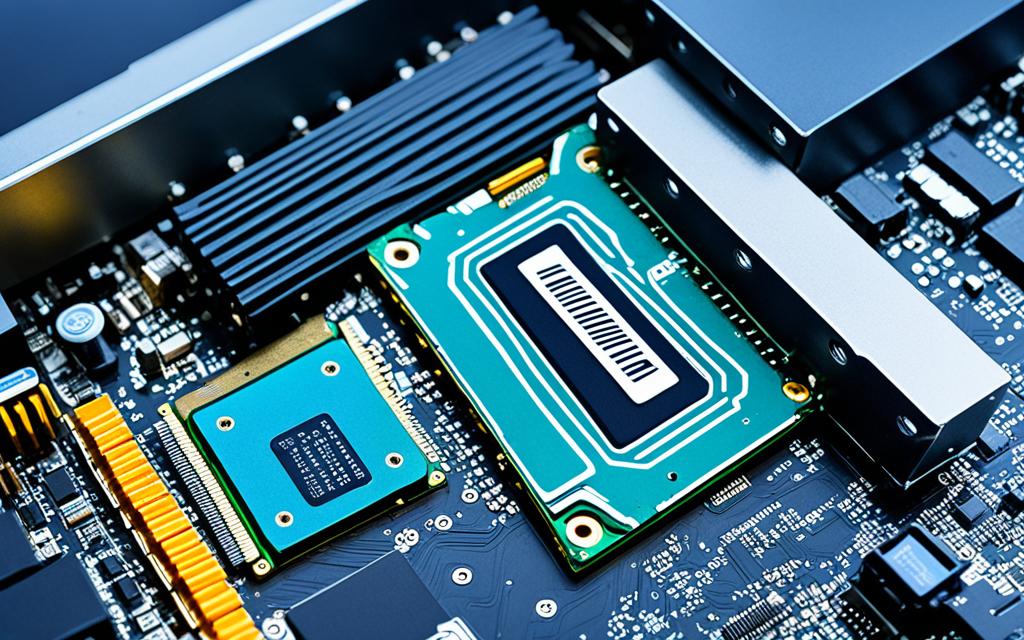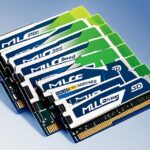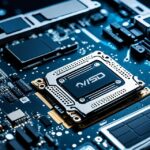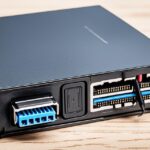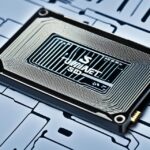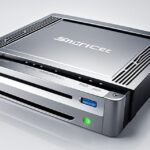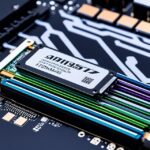Table of Contents
Upgrading to a new SSD can make your PC run faster. But, it’s important to check if the SSD works well with your motherboard. Using the wrong SSD might cause problems or it might not work at all. As SSDs become more popular, knowing how to match them with motherboards is key. You need to consider interface types, connector shapes, and size limits. Understanding these factors will guide you to choose the right SSD.
There are ways to check if an SSD will work with your motherboard. Sometimes, motherboards, especially old ones, may not show SSD details properly because they’re not fully compatible1. Knowing about these possible issues is very important. It helps you pick the best SSD, making your computer upgrade smooth and improving how your PC works.
Key Takeaways
- SSD compatibility is crucial for optimal performance.
- Understanding interface types influences effective upgrading SSD decisions.
- Older motherboard models may exhibit compatibility limitations.
- Five steps exist for troubleshooting SSD and motherboard compatibility.
- SSDs can be significantly faster than traditional HDDs, enhancing system responsiveness.
Understanding SSD Types and Interfaces
Picking the right SSD is important as different types have unique interfaces and performance levels. Knowing about these helps you choose wisely based on what you need.
Explaining SATA, M.2, PCIe, and NVMe
SATA SSDs are a classic choice, available in 2.5-inch and 3.5-inch sizes. They offer speeds up to 6GB/s. The M.2 form factor is smaller, fitting both SATA and PCIe interfaces for more flexibility. PCIe drives connect faster, with some reaching 14,000MB/s speeds. NVMe technology enhances PCIe drives, speeding up data transfers for rigorous tasks.
Differences in Performance and Speed
NVMe drives outperform SATA ones, delivering three to ten times more speed. This is key for heavy tasks like video editing or gaming. Knowing the differences helps boost your system. Upgrading your SSD improves speed and enjoyment of your computer. For tips on upgrading, check this guide.
Identifying M.2 Connector Shapes
Understanding M.2 connector shapes is key to ensure your SSD fits your motherboard. M.2 connectors come in two shapes: B-key and M-key. These shapes are essential for matching SSDs to the right M.2 slots. The keys help align the SSD correctly and determine what the device can do.
Key Differences: B & M Keys
The B-key design is for SATA M.2 SSDs and supports a PCIe x2 setup, which means six contacts sit between pins 12 and 19. On the other side, the M-key design fits PCIe x4 SSDs, showing five contacts between pins 59 and 66. Knowing your motherboard’s M.2 slot type helps you choose the right SSD.Learn more about M.2 compatibility.
| Key Type | Supported Interface | Contact Configuration | Maximum Performance |
|---|---|---|---|
| B-key | SATA / PCIe x2 | Six contacts (pins 12-19) | Up to 6 Gb/s (SATA) |
| M-key | PCIe x4 | Five contacts (pins 59-66) | Up to 31.5 Gb/s (NVMe) |
Most new motherboards have two or three M.2 slots. However, some older ones might not have any2. Knowing about M.2 connector shapes helps you pick the right SSD. It also affects your system’s performance and potential3.
How to Tell if SSD is Compatible with Motherboard
Figuring out if your SSD and motherboard work together requires a few key steps. First off, you need to check motherboard specifications to find out what interfaces and sizes it supports. This is crucial for making sure your SSD fits with what your motherboard can handle. You’ll need the model of your motherboard to get these details. You can find this through diagnostic tools or by looking it up manually.
Checking the Motherboard Specifications
To check motherboard specifications correctly, start by identifying the motherboard model. Then, use the manufacturer’s website or their documents for accurate compatible SSD types. Commonly used SSDs include 2.5-inch SATA, M.2 SATA, M.2 NVMe, and PCIe SSDs. Their performance differs, with SATA being slower, capped at 600 MB/s4, while M.2 NVMe SSDs, especially under the PCIe 4.0 standard, can reach speeds up to 7,000 MB/s4.
| SSD Type | Speed (MB/s) |
|---|---|
| 2.5-inch SATA SSD | 600 |
| M.2 SATA SSD | 600 |
| M.2 NVMe SSD (PCIe 4.0) | 7000 |
| PCIe SSD | Varies |
It’s important to steer clear of SSDs with lower performance, like those without DRAM, as they’re less reliable. Look at endurance ratings, such as TBW or DWPD, to understand an SSD’s lifespan and how well it’ll hold up under normal use4.
Utilising Manufacturer Tools for Compatibility
Using SSD compatibility tools from brands like Crucial makes this much easier. These tools help you ensure your SSD will match your current system. Since M.2 slots can fit either SATA or PCIe SSDs, confirming your motherboard supports the correct type is essential5. Also, M.2 SSD sizes vary, including lengths like 22110 (110mm), 2280 (80mm), and smaller ones like 2230 (30mm)5. Bigger SSDs usually offer more storage, so picking the right size is crucial.
Exploring M.2 SSD Sizes
M.2 SSDs come in different sizes. These sizes are crucial for your computer’s performance and how it fits with your motherboard. Getting to know the various sizes can help your system work better.
Most Common M.2 SSD Lengths
The most seen M.2 SSD lengths are 2230, 2242, 2260, and 2280. They are all 22mm wide. Each one has its own use. For example, the 2280 SSD, which is 80mm long, fits well in most desktops. Laptops might need the shorter ones due to space issues6.
Smaller M.2 SSDs like 2230 or 2242 are perfect for ultrabooks and compact gadgets. They make these devices easy to carry without losing speed7.
Impact of Size on Compatibility and Performance
The length of an SSD can affect both how well it works with your computer and its speed. Longer SSDs usually have more storage space and faster speeds. They can reach speeds over 7,000 MB/s6.
Your motherboard’s M.2 slots might differ. So, matching the SSD size with your motherboard ensures it runs smoothly8. Picking the right M.2 SSD size can make your computer faster and more compatible7.
Practical Steps to Ensure Compatibility
To successfully check if an SSD will work with your motherboard, first make sure the SSD’s interface and connector fit your motherboard’s specs. Next, it is important to measure the SSD’s size to ensure it fits in the M.2 slots on your motherboard. For the best advice, look at your motherboard’s manual or visit the manufacturer’s website to get the exact specifications.
Knowing that SSDs can boost your system’s speed up to 10 times faster than HDDs is key, especially for heavy tasks9.
Also, SSD upgrades are sought after because they work well with both laptops and desktops, making the SSD upgrade process quite successful in most modern systems9.
- Check interface types (SATA, NVMe).
- Verify connector types (B key, M key).
- Measure the SSD length against M.2 slot specifications.
- Consult your motherboard’s documentation for supported SSDs.
- Consider professional assistance if unsure.
By doing these checks before you buy and following the right steps to install, you can greatly reduce the chance of SSD and motherboard mismatch. This ensures your system works well and efficiently.
Popular SSD makers like Samsung, SanDisk, Crucial, and Toshiba offer many options suitable for different setups.
The interest in moving to SSDs is growing because people want more speed and efficiency from their computers.
Being thorough in checking compatibility can really improve your computer’s performance, taking it beyond the usual limits10.
Conclusion
Switching to a solid-state drive (SSD) can make your computer much faster and more efficient. But you must check if the SSD will work with your motherboard. Knowing about different SSDs, like the super-fast NVMe ones, can help you choose wisely11.
It’s also key to know about connector shapes and sizes to avoid any issues. Tools from the maker of your motherboard can help ensure the SSD fits right. A good match means your computer will handle multiple tasks better and be quicker in response. To dive deeper, check out how to pick the right SSD and steer clear of mistakes.
These steps help your computer handle future demands while boosting its current speed. Starting your journey in improving storage with the right knowledge leads to a better computing experience12.
FAQ
How can I check if my SSD is compatible with my motherboard?
To find out if an SSD fits with your motherboard, start by looking up your motherboard’s specs. You can figure this out using diagnostic tools or by manually checking. Make sure to see if the M.2 slots match the SSD’s interface and size.
What types of SSDs are available?
There are different SSD types such as SATA, M.2, PCIe, and NVMe. Each has its own interface and speed, with PCIe and NVMe being much quicker than SATA.
What is the difference between B-key and M-key connectors on M.2 SSDs?
B-key connectors work with SATA M.2 SSDs, whereas M-key connectors are for PCIe SSDs or dual-mode. It’s vital to know your motherboard’s M.2 setup since B-key SSDs won’t fit into M-key slots.
Are all M.2 SSD lengths compatible with all motherboards?
Not all M.2 SSD lengths fit all motherboards. Sizes like 2230, 2242, 2260, and 2280 exist, so it’s crucial to check your motherboard for SSD length compatibility before installing one.
How does the interface type affect SSD performance?
The type of interface has a big impact on SSD speed. SATA’s top speed is 6GB/s, but PCIe can go much faster. Gen 5 PCIe hits speeds up to 14,000MB/s. NVMe also helps achieve higher transfer speeds.
What are the benefits of upgrading to an SSD?
Switching to an SSD can greatly speed up your computer. A fitting SSD will work well, boost efficiency, and make your computer quicker and more responsive overall.
How can manufacturers help with SSD compatibility?
Manufacturers like Crucial offer tools to help you check if their SSDs will work with your hardware. This makes finding the right SSD easier.
Source Links
- https://superuser.com/questions/1349499/motherboard-uefi-doesnt-detect-m-2-ssd-drive – Motherboard UEFI doesn’t detect M.2 SSD drive
- https://www.kingspec.com/news/how-to-determine-the-compatibility-of-m2-pcie-ssd-with-the-motherboard.html – How To Determine The Compatibility Of M.2 PCIe SSD With The Motherboard
- https://www.atpinc.com/blog/what-is-m.2-M-B-BM-key-socket-3 – What is M.2? Keys and Sockets Explained
- https://www.linkedin.com/pulse/how-choose-best-ssd-avoid-common-mistakes-blg-technologies-s211c – How to Choose the Best SSD and Avoid Common Mistakes
- https://www.xda-developers.com/m2-ssd-compatible-with-motherboard/ – How to know if an M.2 SSD is compatible with your motherboard
- https://www.seagate.com/blog/types-of-ssd-sata-nvme-m2-u2-and-pcie/ – Explore the Different Types of SSDs: SATA, NVMe, M.2, U.2, and PCIe | Seagate US
- https://www.corsair.com/us/en/explorer/diy-builder/storage/ssd-form-factors-explained/ – SSD Form Factors explained
- https://medium.com/@mciwuala/troubleshooting-guide-resolving-m-2-ssd-recognition-issues-after-a-bios-update-94caef680df7 – Troubleshooting Guide: Resolving M.2 SSD Recognition Issues After a BIOS Update
- https://scot-comp.co.uk/upgrading-the-ssd-in-your-laptop-for-faster-speeds/ – Upgrading the SSD in Your Laptop for Faster Speeds
- https://www.backblaze.com/blog/ssd-upgrade-guide/ – How to Upgrade Your Computer: Migrating from HDD to SDD
- https://www.electronicshub.org/does-my-motherboard-support-nvme/ – Does My Motherboard Support NVMe?
- https://www.pugetsystems.com/labs/articles/overview-of-m-2-ssds-586/ – Overview of M.2 SSDs

